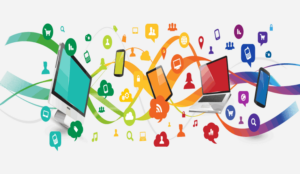Annette Miesbach at NICE inContact shares insights for improving your digital strategy.
2020 was certainly a year unlike any other. A global pandemic of previously unimaginable extent has fundamentally changed the way we live, work and interact with each other, not only privately but also in a business environment.
The use of digital channels has been on the rise for many years, both for how we communicate in our personal life, as well as for how we interact in a business environment. But in this past year, we have seen digital transformation adoption accelerate exponentially and, not surprisingly, we have seen this trend reflected in the contact center.
Digital Is on the Rise
Consumers prefer digital channels – it is a proven fact that customers generally are happier when they use digital channels. Look into Net Promoter Score (NPS) for – as an example – the webchat channel over the last few years, it’s quite eye-opening: NPS started at 21 in 2018, then fell to 13 the following year but is now trending up again with 15 in our latest 2020 consumer research.
Other digital channels present a similar picture. While currently not as frequently used or provided as webchat, customers really like using mobile apps, social messaging platforms, and video chat to interact with companies.
Obviously, those customer preferences are reflected in the channels that many contact centers support today or are looking to add to their contact center environment soon.
Dimension Data, for example, found in their 2020 Global Customer Experience Benchmarking Report that “digital channels rule” and that digital and AI/Automation is where contact centers plan to invest.
A second fundamental change that many agents have been faced with is the fact that their workplace has literally been turned inside out and upside down. Working from the home office is not new news by a far cry – many contact centers had agents in the home office before COVID-19 happened – mainly because in particular for high-profile agents that are difficult to hire, expensive to train, and not easy to retain, the ability to work from home was a perk.
By and large, though, agents were expected to be in attendance, at the actual call center location or maybe a branch office. Has that ever changed in 2020!
Post-pandemic, about three-quarters of agents, worked from home – either some or all the time:
That, of course, has had a huge impact on contact centers and their agents – both the agents “left behind” as well as the ones that moved to the home office. Limited watercooler conversations and leaning over to ask the guy in the next cubicle a quick question is not an option anymore in many cases, and in-person meetings or trainings are still a thing of the past.
On top of all that let’s not forget the challenges in dealing with a mostly remote workforce for contact center supervisors and managers – their job did not exactly become easier, either.
For now, though, let’s get back to the agent, and since we now have a good understanding of the changes, how about we look at some of the challenges, and what can be done to help agents better deal with them in 2021 and beyond.
Digital transformation from call to contact center will not go away, and there’s a good chance that some of the changes in where we work will stay around for a while yet.
Digital Is the New
Basic call centers where agents spent days on end answering one phone call after another have been around for decades. Answering the phone all day and talking to customers definitely has one thing going for it: it is quite predictable.
When all is said and done, handling a customer issue on the phone follows the same structure for every interaction: The phone rings, the agent answers, talks with the customer – maybe reaches out to an expert, fellow agent, or supervisor, hopefully, resolves the customer issue, disconnects the call and wraps up the interaction. That is not easy, but relatively predictable.
With the ongoing evolution to digital interactions, though, agents are facing new and different challenges. Let’s talk about some of those, and what can be done to help agents succeed:
Challenge #1: So Many Channels, So Many Tools
A phone call is a phone call is a phone call. There are some handling “options” – agents can transfer, or consult, or conference someone in. But the interface agents use to handle calls is the same and looks and behaves the same way for every call an agent handles.
For digital channels, this may be very different. When companies first started looking into digital interactions, especially channels beyond the more “traditional” digital such as email or webchat, many did so by adding digital point solutions.
Those point solutions often were not even used in the contact center; instead, interactions were often handled in the marketing team – or with a separate group of agents “reserved” for those new channels, but apart from the traditional contact center.
What those agents did was customer service – only in a new channel. So adding those interactions back into the contact center made sense – only that meant that some agents now had a different tool or even more than one desktop: one for traditional channels and another one – or even more than one – for channels that were added later on: WhatsApp, Facebook Messenger, Twitter Messages, Apple Business Chat, and so on.
While sometimes considered a necessary evil, this is obviously not a good thing for the agent. Not only does it add to the plethora of windows and tools agents have to handle, but it also makes it so much harder to keep track, be consistent and focus on what agents should focus on: helping customers.
Solution #1: Consolidate
Find a contact center solution that allows the handling of most, if not all, interaction channels on one platform and in a unified agent interface. It will not only help your agents but also make digital easier to administer and manage.
With a solution like the CXone platform that supports more than 30 interaction channels – from traditional voice-over webchat to numerous messaging platforms, agents get one common interface across all channels they handle. And to keep things simple, the MAX – My Agent eXperience agent adds on Workforce Management and Quality Management Analytics.
That way, all your agents need is in one interface – juggling multiple interfaces and windows is a thing of the past.
Challenge #2: Real-Time Versus Asynchronous
As far as interaction channels go, the advent of digital has added an all-new dimension to looking at contact center interactions: how “real time” are customer interactions. It’s quite clear for a voice call: it’s real time. As soon as the agent answers the call, the customer expects immediate and undivided attention.
On the opposite end of the spectrum: email. In most cases, it is perfectly acceptable to take a day or even longer to reply to a customer email. And now, there’s everything in between: webchat is probably more real time, customers expect an agent to reply quickly once they are connected. But for SMS and many social messaging platforms, customers are often ok to wait for a little while, maybe even an hour or so for someone to get back to them.
When they leave a post on a company’s social profile, the range is even bigger – from an hour up to a day. And this applies not only to the initial response but throughout the interaction that can stretch over an hour or even days.
It is deemed perfectly normal for a customer to initiate an interaction by – say – sending a Facebook message, but later in the interaction, they have to step away and only pick up the interaction hours later again.
Unimaginable with a voice call. Perfectly normal with many digital interactions. For call center solutions that assume digital interactions follow a voice call logic for handling, this is a big challenge.
Solution #2: Let the Channel Determine the Handling
The solution to this challenge – while technically not easy to do – is actually quite simple. Your agents need an interface that enables them to handle the different channels according to customer expectations.
Phone calls must be as real time as they have always been since Graham Bell. But for handling a WhatsApp interaction, your agents must have an interface that keeps the interaction active even if the customer disappears for a while.
You want your agent to be able to handle another interaction in the meantime, but when the customer comes back, they expect the agent to pick up exactly where they left off. The ideal solution? Give your agent a consolidated interface that enables them to deal with both.
Challenge #3: Locking Your Agents (and Customers) Into One Channel
As mentioned in the previous challenge, not all channels are created equal (and neither are all agents, of course). Yet many contact centers deprive both the customer as well as the agent of the ability to add or switch between different interaction channels within one interaction.
Simple example: your agent is on the phone with a customer that had to reschedule an appointment. The new time and date have been agreed upon. However, the customer is on the go and does not have the means to note down the new appointment.
There are too many contact centers where this situation will still create a second interaction (e.g. the agent disconnects from the call and either sends an email as a separate contact or the customer asks to be called back later when they are back home).
Solution #3: True OSH
True Omnichannel Session Handling is the best solution for this situation. You allow your agents to add or switch channels whenever it serves to fully resolve the customer’s issue at the first interaction (regardless of how many channels were used in this interaction to achieve that result).
In the case described, the agent could for example offer to send the customer an SMS or email with the new date. This option improves First Contact Resolution rates for the contact center and makes the customer happy.
Challenge #4: Fundamental Changes in the Workplace
With the global pandemic, the way we all work has undergone fundamental changes. It is not the rule anymore that we go to an office every workday morning. And even if we do, what happens at the workplace has changed a lot: social distancing; masks; face shields; disinfectant has become an essential part of workplace equipment for many.
Even more impactful: NICE inContact research with Nemertes research shows that – as mentioned earlier – more agents than ever before have started working from the home office and we expect that this will not just go away even after Covid is finally gone.
Technically, in particular, for companies that used a cloud contact center solution such as CXone, getting agents set up in the home office was not a huge deal; certainly, a challenge because everything had to happen so very quickly, but absolutely doable in most cases.
Working from home, many agents were for the first time in a situation where things that used to feel natural, such as asking a seasoned colleague for advice or giving a hand sign to the supervisor roaming the floor when something went a little pear-shaped, were all of a sudden not an option anymore.
Instead, they were relegated to a home office (or maybe even the kitchen table) and forced to fend for themselves – or were they? And how did they deal with the fact that they lost their line of sight into contact center KPIs – the ones they used to have right in front of them on that big screen up on the wall that everyone could see from where they worked?
And let’s not forget that agents were not the only ones that had to deal with a completely different workplace situation: the impact on supervisors and managers was just as fundamental.
Not only was there no more face-to-face interaction with many more of their agents than ever before, but there were also all-new challenges for them, too: how to monitor a predominantly work-from-home workforce, how to ensure agents are productive, how to check schedule adherence, how to monitor interaction quality and help when needed – by listening into ongoing interactions and barging in when needed, or provide training to address more systemic issues.
Solution #4:
As mentioned, with a cloud contact center solution like CXone, the purely technical aspects of moving a workforce to the home office were not a major issue. While there were some hiccups and justified concerns around mainly security, technology, and productivity, many customers managed to turn on a dime and move impressive numbers of agents from the office to their homes.
By and large, the most impactful products, tools and features a contact center can have to make it through such a previously unheard-of process unscathed and remain productive wherever their agents are located fall into the following categories:
- Devices, network, and connectivity
Ensure you can provide the hardware your agents need and do run tests to confirm that network requirements are met from the agent’s new workplace; this can also include making sure that your agents have a physical location that is conducive to their being productive. For handling voice calls, prepare your agents to be able to potentially use different mechanisms to receive routed calls – a softphone or another B-leg id needed (call phone or even landline). - Workforce and Quality Management
It is important to confirm that the ways you manage and monitor agent schedules are still available when your agents work from home. Working from home should not negatively impact shifts, so make sure everyone adheres to their schedule as if they were in an office. With CXone Workforce Management software you are well prepared – if you use other tools, make sure they are available when and where needed.
Also, you want to make sure that working from home does not impact interaction quality, which means you still need to monitor how your agents are doing – maybe even a little bit more initially to ensure everyone’s settled in successfully. When additional training is needed – for example to address procedural changes needed due to the different work environment or overall situation, a solution like CXone Quality Management Analytics will empower you to monitor agents regardless of location, analyze and evaluate interactions and provide agents with the feedback they need to stay – or get back on – track, no matter where they work.
Working from home is a big change – make sure you have the means to motivate and inspire your agents with gamification, keep healthy competition alive, and be prepared to help agents with support and online training when needed. - Collaborate in new ways
As mentioned earlier, working from home makes some trusted and true ways to collaborate impossible. However, with a contact center solution that provides real-time status of not only other agents but also back-office experts or other SMEs (who might also work from home), your agents can still reach out and make sure they easily find the help they are looking for. Just make sure your agents know how to best use the tools they have at their disposition.
If you need a little help to prepare, how about taking a look at our Checklist: Managing Work-from-Home Contact Centre Agents; it will help you to prepare for success during an emergency – but won’t do any harm during normal interactions, either.
Challenge #5: So Many Tools, So Many Interfaces
There are many tools agents need access to on an ongoing basis to be able to do their job. And it’s not only contact handling across digital and voice channels that we talked about earlier.
Agents need access to customer data, often located in a CRM or a ticketing system. They schedule their shifts or request time off. Quality management where your supervisor or – in larger centers – a dedicated quality manager reviews interactions and provides feedback in some contact centers is another interface that they must learn, use and manage.
In some centers, even each channel requires a different interface. Long story short: there are contact centers where agents spend a good amount of their time first learning, then managing all the different interfaces they need to do their job.
Solution #5: ONE
The more you can unify your agent’s workplace, the easier it gets for them to become and remain productive. Enabling agents to handle all channels in one interface with consistent controls and processes is a first step that makes it a lot easier for them to streamline handling.
They can focus on the customer they help instead of ALT tabbing back and forth between different windows.
The same applies to your supervisors and managers, too. If they have a single interface where they can monitor agents across all interaction channels, and administer agents, skills, and queues regardless of channel, that saves time and offers a more holistic view of your contact center operation. And better insight will help you to better manage.
There are many more challenges to be written about and addressed – for every single role in the contact center. In the end, though, like Santa and the elves, the best you can do is look at the virtual contact center wish list, prioritize what is most important and achievable – and start planning.
Challenge #6: The Impact of Self-Service
Self-service is a great option for many contact centers – it provides nearly infinite scalability and saves cost. There are pitfalls in implementation in particular for automation and bots that make it one of the channels that many customers are not exactly enamored with yet, but there’s a learning curve, solutions become more intelligent and customers more willing to accept interactions with a non-human.
But what does that mean for the human counterparts? Today, most customers do their homework before they ever reach out to a live agent (if they do so at all). That means that work that ends up with an agent are the cases that AI was not yet smart enough to resolve. In general, live agent interactions are more complex (or more emotional) than they used to be in the past.
Solution #6: Help Agents Work Smarter
There are many ways contact centers can help their agents to better deal with those challenges. To start with: it is indispensable to provide agents with as much information about the customer, their current situation, and their history, as possible.
CRM integration, access to ticketing systems, cross-channel interaction history: anything that will help the agent better understand the customer is helpful. As mentioned earlier, providing a consolidated, user-friendly interface will enable the agent to focus on the customer, not the tool they use.
More sophisticated helpers include:
- Automation and AI: this is not only useful for interactions with the customer but can be used to support the agent, too! For example, automation can take over when the agents have handled the tricky parts of an interaction and take over the mundane parts of an interaction.
- Contact centers can use AI to suggest the next best actions to the agent.
- Solutions such as Predictive Behavioral Routing allow contact centers to match customers with agents they “click” with.
- Sentiment recognition gives the agent fair warning if they are facing an unhappy customer so they can prepare – or you can decide to route difficult calls to more experienced or specially trained agents.
- There’s even solutions that will constantly monitor ongoing interactions and provide agents with real-time guidance and tips on how they can improve in real time, for example, to slow down their talking or show more empathy.
So many challenges, so many solutions. To address changes related to digital transformation this year (and beyond, of course – Rome wasn’t built in a day either), take stock of where you are, then decide what to focus on in your contact center for the coming year.
How about you start with our infographic “The new digital landscape”. It will help you orchestrate customer service according to the new digital reality, and you will end up with all the different instruments (agents, channels, bots, and more) working together harmoniously to create the great customer experience you want while keeping your agents happy throughout the coming year and beyond, no matter what challenges are in store for the future.
This blog post has been re-published by kind permission of NICE CXone – View the Original Article
For more information about NICE CXone - visit the NICE CXone Website
Call Centre Helper is not responsible for the content of these guest blog posts. The opinions expressed in this article are those of the author, and do not necessarily reflect those of Call Centre Helper.
Author: NICE CXone
Published On: 29th Apr 2021 - Last modified: 29th May 2024
Read more about - Guest Blogs, Annette Miesbach, NICE CXone






 NICE CXone combines best-in-class Omnichannel Routing, Workforce Engagement, Analytics, Automation and Artificial Intelligence on an Open Cloud Foundation.
NICE CXone combines best-in-class Omnichannel Routing, Workforce Engagement, Analytics, Automation and Artificial Intelligence on an Open Cloud Foundation. 










